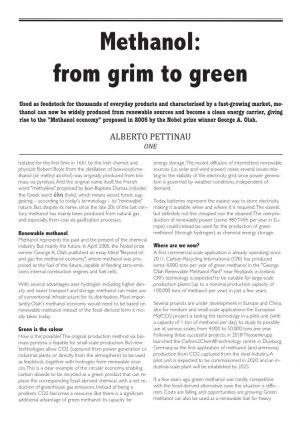 Isolated for the first time in 1661 by the Irish chemist and physicist Robert Boyle from the distillation of boxwood, methanol (or methyl alcohol) was originally produced from biomass via pyrolysis. And the original name itself, the French word “méthylène” proposed by Jean-Baptiste Dumas, includes the Greek word ύλη (hyle), which means wood, forest, suggesting – according to today’s terminology – its “renewable” nature. But, despite its name, since the late 20s of the last century, methanol has mainly been produced from natural gas and, especially, from coal via gasification processes.
Isolated for the first time in 1661 by the Irish chemist and physicist Robert Boyle from the distillation of boxwood, methanol (or methyl alcohol) was originally produced from biomass via pyrolysis. And the original name itself, the French word “méthylène” proposed by Jean-Baptiste Dumas, includes the Greek word ύλη (hyle), which means wood, forest, suggesting – according to today’s terminology – its “renewable” nature. But, despite its name, since the late 20s of the last century, methanol has mainly been produced from natural gas and, especially, from coal via gasification processes.
Renewable methanol
Methanol represents the past and the present of the chemical industry. But mainly the future. In April 2005, the Nobel prize winner George A. Olah published an essay titled “Beyond oil and gas: the methanol economy”, where methanol was proposed as the fuel of the future, capable of feeding zero-emissions internal combustion engines and fuel cells.
With several advantages over hydrogen, including higher density and easier transport and storage, methanol can make use of conventional infrastructure for its distribution. Most importantly, Olah’s methanol economy would need to be based on renewable methanol instead of the fossil-derived form it mostly takes today.
Green is the colour
How is this possible? The original production method via biomass pyrolysis is feasible for small-scale production. But new technologies allow CO2 (captured from power generation or industrial plants, or directly from the atmosphere) to be used as feedstock, together with hydrogen from renewable sources. This is a clear example of the circular economy, enabling carbon dioxide to be recycled as a green product that can replace the corresponding fossil-derived chemical, with a net reduction of greenhouse gas emissions. Instead of being a problem, CO2 becomes a resource. But there is a significant additional advantage of green methanol: its capacity for energy storage. The recent diffusion of intermittent renewable sources (i.e. solar and wind power) raises several issues relating to the stability of the electricity grid, since power generation is governed by weather conditions, independent of demand.
Today, batteries represent the easiest way to store electricity, making it available when and where it is required. The easiest, but definitely not the cheapest nor the cleanest! The overproduction of renewable power (some 480 TWh per year in Europe) could instead be used for the production of green methanol (through hydrogen), as chemical energy storage.
Where are we now?
A first commercial-scale application is already operating: since 2011, Carbon Recycling International (CRI) has produced some 4,000 tons per year of green methanol in the “George Olah Renewable Methanol Plant” near Reykjavik, in Iceland. CRI’s technology is expected to be suitable for large-scale production plants (up to a nominal production capacity of 100,000 tons of methanol per year) in just a few years.
Several projects are under development in Europe and China, also for medium and small-scale applications: the European MefCO2 project is testing the technology in a pilot unit (with a capacity of 1 ton of methanol per day) to study its possible use at various scales, from 4,000 to 50,000 tons per year.
Following these successful projects, in 2018 Thyssenkrupp launched the Carbon2Chem® technology centre in Duisburg, Germany, as the first application of methanol (and ammonia) production from CO2 captured from the steel industry. A pilot unit is expected to be commissioned in 2020, and an industrial-scale plant will be established by 2025.
If, a few years ago, green methanol was hardly competitive with the fossil-derived alternative, now the situation is different. Costs are falling, and opportunities are growing. Green methanol can also be used as a renewable fuel for heavy-goods transportation, with a significant contribution in terms of greenhouse gas emissions reduction. Today, the shipping and aviation sectors are mainly based on fossil-derived fuels, with more than 300 million tons of CO2 emitted every year in Europe (according to the data published by Eurostat and the European Environmental Agency). Green methanol can help to decouple this sector from fossil fuels.
The way was opened by the Swedish shipping company Stena Line in 2015 when the “Stena Germanica” ferry was modified to be fed with green methanol. Several companies are launching similar initiatives.
A fast-growing market
The international methanol market is currently going through a phase of huge expansion, with a worldwide production estimated by the Methanol Institute as about 110 million tons per year and a daily demand of 200,000 tons: a global industry that generates $55 billion each year with over 90,000 jobs.
Methanol is now widely used in the chemical industry for the production of thousands of everyday products: construction materials, foams, resins, plastics, coatings, polyester, a countless number of pharmaceutical products, and many more. And, more recently, as a clean fuel or as an energy carrier for the production of other fuels, including gasoline.
The final challenge
The challenge now is to make green methanol fully competitive to boost its commercial diffusion in place of fossil-derived methanol. Advanced materials and new concepts have been recently proposed to capture CO2 from power generation and industrial plants or directly from the environment. A key role can also be played by novel technologies for hydrogen production from renewables that are expected to become competitive in 5-10 years.
And, last but not least, further optimisation of the CO2 hydrogenation process – at the core of green methanol production – is required to improve both conversion efficiency and plant flexibility. New technologies, such as solid oxide electrolyser cells (SOEC) are under development to enable cheaper and more flexible hydrogen production. But the most critical role will be played by optimisation of the catalyst materials needed to accelerate the key reaction between CO2 and hydrogen. Currently, most of the CO2-to-methanol units use conventional copper-based catalysts developed for methanol synthesis from syngas, capable of combining low costs and high activity – a measure of how much the catalyst increases the reaction rate.
Several specific solutions for CO2 hydrogenation have been recently proposed to maximise both the carbon dioxide conversion and the selectivity of the catalyst. The Sardinia-based Italian company Sotacarbo has developed the recently patented “Actirem” catalyst, based on copper and zinc oxides and designed to combine two innovative methods. It brings together a high conversion efficiency, tolerance to oxygen, and a stable activity without any pre-treatment, as well as significant advantages in terms of cost and safety. It took some time, but Boyle’s seeds are finally sprouting more than ever.
Alberto Pettinau



